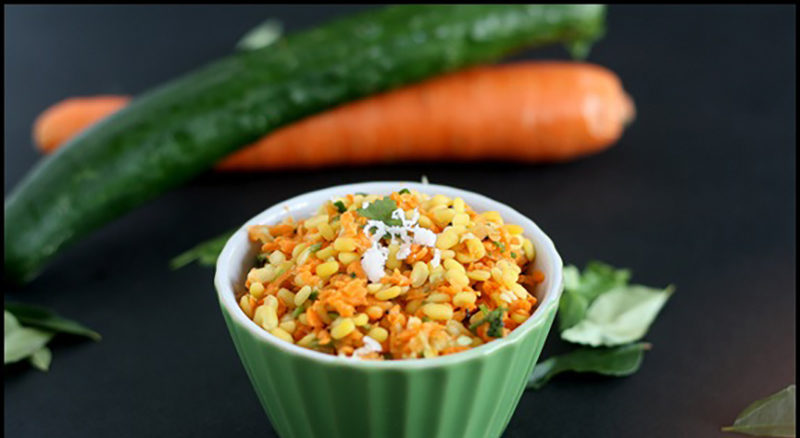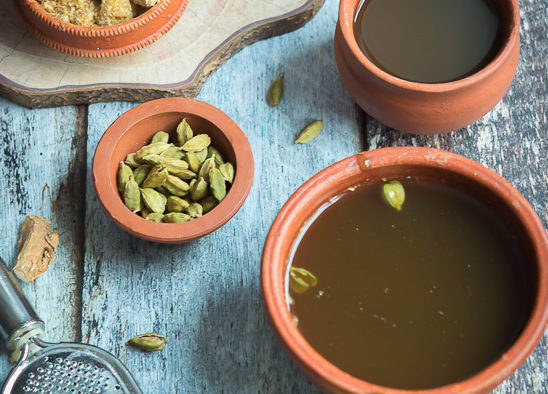There are six seasons in the Hindu calendar and each season has a prescribed food system according to Ayurveda. This is known as Ritucharya, Ritu meaning season and charya meaning guidelines. Our body has a particular energy constitution- Vata, Pitta and Kapha or a combination of any of the three. Each season can have an effect on the balance of the body if the required conditions are not met.
Dr Ahalya, Principal of Government Ayurvedic Medical College, Bengaluru says, “According to the diurnal periods or the seasonal clocks, we need to eat right on time”, which she quotes, “Kaala Bhojanam Aarogya Karanaam”.
There are two periods- Uttarayana and Dakshinayana and each constitutes three seasons. Dakshinayana - Sharath, Hemantha and Shishira. Uttarayana- Vasantha, Grishma and Varsha. Vasantha Ritu or the spring season started on March 25th this year and that is also celebrated as Ugadi / Gudi Padwa. Spring welcomes warmth after a long period of winter. During winter, Kapha accumulates in the body. This kapha is liquefied in spring and this leads to the weakening of the digestive fire or Agni. This leads to digestive disorders. Food items like jaggery, ginger, cumin, coriander, black pepper, lime juice, black salt can keep the digestive juices flowing and the agni going on.
On Ugadi, people tie Mango and Neem leaves at the entrance of the house. It depicts auspiciousness and is believed to ward off evil. Scientifically it is known to be effective against gram positive bacteria like Staphylococcus. Neem leaves ward off tiny insects from entering the house. Raw Mango is hero-ed in the dishes. Mango rice (chitranna) and mango pachadi are made on this day. A paste of raw mango, neem, tamarind and jaggery is made. The taste of the dish is usually sweet and sour and is said to symbolise that life is a mixture of happy and sad phases. The mango-neem pachadi incorporates all the six different flavours – sweet, sour, salty, astringent, spicy and bitter. Neem contains Azadirachtin which imparts antimicrobial nature to it. Neem flowers are dried and used in the preparation of the pachadi. Neem flowers were also believed to be used to protect rice in the olden days. The ayurvedic qualities of green mango are sour, astringent and cooling. They should not be eaten alone or in large quantities because they can aggravate the doshas, especially Pitta dosha. However,in the form of pachadi, they help digestion and improve the flavor of food. As Ugadi has already passed, I hope everyone prepared these dishes and prayed for a happy and healthy new year.
Every year on the Chaitra Masa Shukla Paksha navami, the nation celebrates the birth of Lord Rama. Chaitra masa is the first month of the year in the Hindu calendar and is associated with the beginning of the Spring season also known as Vasantha Ritu. Paksha in Sanskrit means fortnight. The period of 15 days from the new moon day (Amavasya) to the full moon day (Poornima) is regarded as Shukla Paksha as it depicts the brightening of the moon (shukla meaning white). Before going to the details of the prasadam, let me give you an insight into the celebrations of Rama Navami across the nation.
Rama Navami is joyously celebrated by people in various manners across the country. In the north, Ram Navami falls on the ninth day of Navratri. The north of India, especially Uttar Pradesh, celebrates Navratri twice a year- once during the chaitra masa and once during the Ashwina Masa (autumn). Lord Rama was the seventh Avatar of Lord Mahavishnu and came down to Earth to protect the civilians from the Rakshasa Ravana. Ram rajya or Rama’s rule was a sign of peace and prosperity all over the nation.
Ra means radiance and Ma means me. Rama means the light in me. This light within all of us is what Lord Rama signifies and Ram navami truly celebrates this divine light within us. He was born to the King of the Ikshvaku clan Dasharatha and Queen Koushalya in Ayodhya. Dasharatha means Ten chariots- this depicts the five sense organs (Jnanedriya) and the five external organs (Karmendriya). Koushalya means skill. Ayodhya is one that cannot be destroyed. The true essence of this is- Our body is Ayodhya, the king of our body is the five sense organs and the five external organs. Our sense organs work outwardly, but using the queen of our body, Skill, these sense organs can be drawn inward which will bring out the divine light within us, which is Lord Rama himself. Ram navami is thus the celebration of this divine light in us.
Celebrations across the nation happen with great fervour. Ayodhya being the central focus, have Ratha Yatras or chariots on which Lord Rama with Devi Sita, Lakshmana and Lord Hanuman are taken on a procession on the streets. Effigies of Ravana and other rakshasas are burnt in the evening, depicting good over evil. Cradles with baby Rama are hung in temples showing the birth of Lord Rama. Bhajans and hymns are sung all throughout the day. Either Akhanda Ramayana is read or only Sundara Kanda of the Ramayana is read on this day.
In Rameshwaram, people take a dip in the sea and proceed to the Ramanathaswamy temple to offer their prayers.

It is believed that the wedding between Rama and Sita took place in Bhadrachalam, Andhra Pradesh. A ceremonial wedding ceremony- Sitarama Kalyana- is conducted.
Now, time for prasadam. A drink made out of jaggery called Panaka is served in every household and temples along with Neer Mor (Spiced buttermilk) and a cucumber and lentil salad. The idea behind these prasadams or offerings is that Ram Navami is celebrated during one of the hottest months of the year and these offerings will provide the cooling one needs at that time. Fascinating!
Panaka is a sweet drink with jaggery and lime juice and is seasoned with cardamom, ginger. It is also served chill as it is a coolant for the hot weather.
Jaggery is unrefined sugar prepared from sugarcane. It is rich in minerals like calcium, iron phosphorus, magnesium, potassium and traces of zinc and copper (1). It also contains Folic acid and B-complex vitamins. (1) Ashtanga Hrudaya chapter 5 shloka 47 and 48 give us an insight into the benefits of jaggery- Natishleshma kara – does not increase Kapha to a large extent Srushtamutrashakrut – increases volume of urine and faeces. If it is not prepared properly, it causes intestinal worms, increases chances of Kapha disorder in marrow, blood, fat tissue and muscles. Old jaggery is good for the heart, and should be consumed (Ashtanga Hridaya Sutrasthana). Freshly prepared jaggery increases Kapha and causes indigestion. Ginger cleans the tongue thereby increasing appetite.
Dr Ahalya says, "if you don't feel hungry even after 6 hours, a mixture of ginger and Saindhava lavana or rock salt taken before food for a week will improve your digestive fire.”
It also regulates metabolism and improves digestive capacity. Vata – Kapha pacifying effect of ginger plays an important role in anti-inflammatory effect. According to ayurveda, a ‘sotha’ or inflammation, may be due to either ‘avritta’ or vata-kapha; or due to obstruction of vata due to kapha. In any situation ginger with its hot, oily, pungent, sharp and breaking down properties relieves the inflammation. (2) Cardamom also known as Ela in sanskrit is considered an excellent digestive, especially beneficial in reducing bloating and intestinal gas. It is excellent for balancing Kapha, particularly in the stomach and the lungs.

Another prasadam offered is Neer mor which is spiced buttermilk. It is made of buttermilk, salt, asafoetida and curry leaves. Curry leaves are vata-pitta pacifying. Asafoetida is a key digestion promoting herb in ayurveda. By improving the digestion, asafoetida helps prevent the formation of excess phlegm and ama.
Kosambari is a lentil salad seasoned with curry leaves and mustard seeds. Cucumber and carrot is usually added to this and this is served along with panaka and neer mor. Moong dal is a perfect summer food and is a natural coolant as is cucumber.

It is no coincidence that these three prasadams are offered on Rama Navami to beat the heat and to balance the doshas in the body.
In the north, since it falls on the last day of Navaratri, women who have prayed to Goddess Durga over the nine days, invite nine kanya girls, those who haven’t hit puberty yet, worship them and serve them a feast which includes poori (flattened bread), kala chana and sooji halwa (a semolina sweet treat). Kala chana is viewed as agneya, it is a metabolism booster and helps in removing toxins with the help of its high fibre content. It has a high fibre content and that helps digestion and colon health, as transit through the digestive system is slower. Semolina’s natural sweetness helps to ground Vata and Pitta.
With the whole country celebrating this important day, it is hard to miss out on the festivities and the great food and as Ayurveda says- Keep the appetite strong all way through!!!!
References:
- Rajesh CK, Shajahan MA, Shahul Hameed A. Ayurvedic review on Guda (Jaggery). Ayurpharm Int J Ayur Alli Sci. 2016;5(5):68-76.
- Sandeep S. Commentary on Therapeutic Role of Ginger (Zingiber officinale) as Medicine for the Whole World. Int J Pharmacogn Chinese Med 2017, 1(1): 000102




